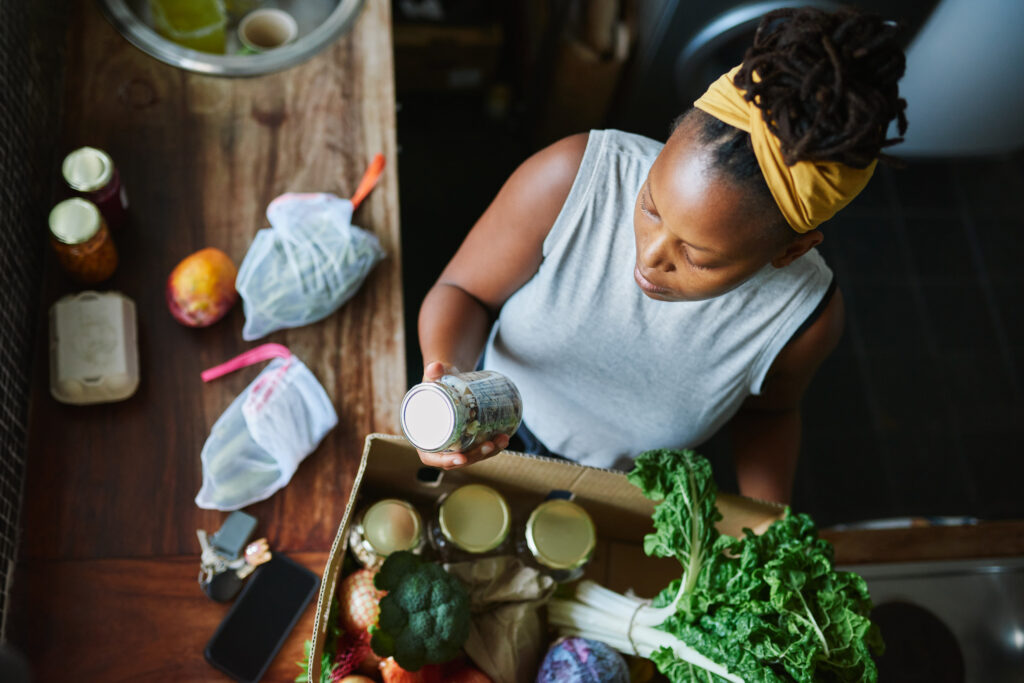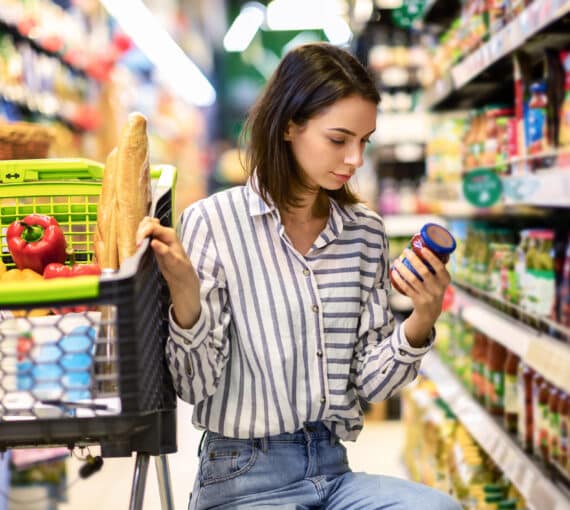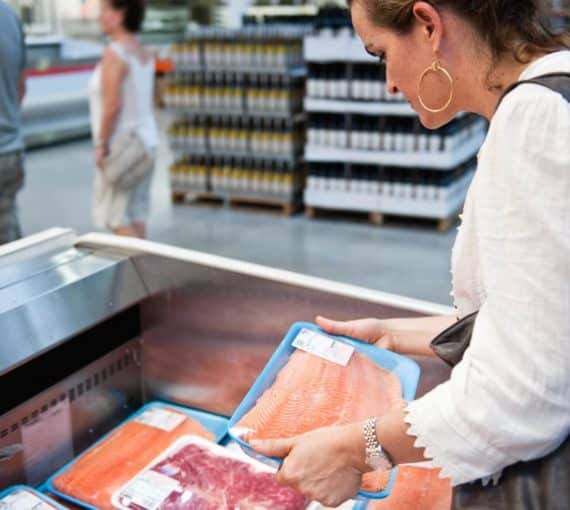
Claims on food, body care and cleaning products labels can be confusing and misleading. Learning how to spot non-regulated terms and trusted ecolabels is essential to making informed choices.
Food, body care and cleaning product labels often say “natural,” “sustainable” or “biodegradable.” These terms are not regulated in Canada. A product with these words but without a reputable ecolabel can give people a false sense of environmental responsibility. This makes it difficult to differentiate between actual sustainable products and those that only appear to be.
Want to make informed choices? Learn how to spot non-regulated terms and understand the significance of credible ecolabels. When you know how to recognize legitimate certifications and understand what they represent, you’ll feel confident avoiding products that may have negative impacts on the environment and human health. And you’ll avoid being mislead by claims designed to exploit eco-conscious shoppers.
Greenwashing on product labels
Greenwashing is when companies make exaggerated or false claims of environmental or social responsibility to cover harmful and/or unethical practices. A 2021 study revealed that eight in 10 people in Canada value sustainability, with over half buying more eco-friendly products compared to five years ago. As people become more eco-conscious, they’ll buy products that align with their values. To meet consumer demands, many companies are adjusting their practices to offer more environmentally friendly products. To find those, people turn to product labels and/or descriptions for guidance and assurance. But not all these efforts are genuine. Some companies and brands use unregulated terms as greenwashing tactics to create the illusion of sustainability without adhering to or adopting eco-friendly practices and standards.
Enter: the buzzwords! “Green,” “eco-friendly” or “natural” are just a few examples of popular terms often used as greenwashing techniques in labelling and advertising. Most of these terms are not regulated in Canada. They can be applied on products without third-party verification or proof. This lack of oversight allows companies to mislead consumers into believing their products are environmentally responsible when they may not be — especially when the product doesn’t have a verified eco-certification.
Other signs of greenwashing:
- Misleading imagery. Some companies use images of nature, greenery or other symbols in their advertising and branding. This creates an impression of environmental responsibility when core business practices and ingredients may be unsustainable.
- Token sustainable products. Companies may introduce a small line of eco-friendly products while continuing to use unsustainable production methods. This creates an illusion of a commitment to sustainability.
- Lack of transparency. Does the company disclose information about ingredient sourcing, labour conditions or environmental impacts? You can’t assess a company’s true sustainability efforts without those.
What's an ecolabel or eco-certification?
Ecolabels are visual marks or symbols used on products to indicate that they meet certain environmental and/or ethical standards. They’re typically placed on the external packaging of the product and/or on the product. Most products with an ecolabel undergo a rigorous eco-certification process that evaluates the product and company against specific environmental or ethical criteria.
The landscape of eco-certifications on products in Canada is complex. The federal Office of Consumer Affairs “does not provide oversight on environmental labels and claims.” Determining the legitimacy of eco-certifications on products in Canada requires research into the specific process, standards and guidelines.
Below are some of the most trusted ecolabels for each category, based on history and reputation, and unregulated terms to be wary of.
Tip! Displaying an ecolabel symbol is voluntary. Products may have “certified by…” on the label instead. Inspect product labels and packaging thoroughly.
Eco-certification processes may also be too costly or time-intensive for small businesses with good practices. Use due diligence and inquire.

Remember!
Some of these non-regulated terms may be true claims when on a product sealed by a verified certification body. Inspect packaging and company websites for certifications.
Some products new on the market may have not yet undergone through an eco-certification process. Check ingredients and do research.
Still not sure? Ask the company. Or write an online product review. Many companies take customer feedback seriously. Say you care about environmental and human health and safety and are concerned about ingredients, materials and claims.

Tip!
Several apps can help you make informed decisions when shopping for cosmetics, body care and cleaning products. Many allow you to search for and/or scan the product barcode of a product to see what ingredients are a concern to environmental and/or human health.
TRUSTED ECOLABELS AND UNREGULATED TERMS
Trusted ecolabels for all products
A few eco-certification programs cover a wide array of product types and can be found on food, body care and cleaning products.
- B Corp. Certified B Corporation brands and companies uphold rigorous standards of social and environmental performance, accountability and transparency. Areas covered include employee benefits, charitable giving, supply chain practices and materials sourcing.
- EcoCert. The independent body sets and oversees its own standards for organic and environmentally friendly products. It uses binding contracts, audits and reviews to maintain its reputation as a trusted label for socially responsible, sustainable, organic and fair trade brands. EcoCert administers and oversees more than 150 ecolabels worldwide.
- ECOLOGO. Certified products are independently verified to have a lower impact on the environment and human health. These certifications are voluntary and based on multiple environmental factors across the product’s life cycle.
Food labels
The volume of claims used and certifications available makes understanding food labels challenging. Some claims are heavily regulated in Canada, while others are misleading or vague.
Trusted ecolabels and regulated terms on food labels:
- Canada Organic. “Organic” is a regulated term. Any food product labelled organic and displaying the Canada Organic logo was produced following Canadian Organic Standards and certified by a third party.
- FairTrade Canada. Products with this label meet rigorous standards for social, economic and environmental sustainability. It’s crucial to distinguish this from less stringent fair trade claims and labels that may not meet the same level of transparency and scrutiny.
- Local. Federal government policy is that food products labelled “local” have been produced in the province or territory in which they’re sold. Food sold across provincial borders within 50 kilometres of the originating province or territory can also have this label.
- Rainforest Alliance Certified. One or more key ingredients in products with this label come from a farm or forest operation that meets comprehensive standards that protect the environment and promote the rights and wellbeing of workers, their families and communities.
- USDA Organic. This verifies that the product has been certified organic by the U.S. Department of Agriculture and imported under Canada’s organic equivalency agreement.
Commonly used non-regulated terms and claims on food labels:
Some food products in Canada are more prone to being marketed with non-regulated buzzwords and terms. Animal-based food products, in particular, face far greater consumer scrutiny regarding environmental, ethical and health concerns. This prompts producers and suppliers to use regulated and non-regulated certifications to appeal to market demands.
Eggs and poultry:
- Cage-free and/or free-run. Implies that chickens were not kept in cages. The reality? Chickens can move freely indoors but may not have outdoor access or better living conditions beyond the absence of cages. Conventional cages in Canada must be phased out by 2036 as per the Code of Practice for the Care and Handling of Laying Hens.
- Farm fresh. Implies that the product is fresh and comes directly from a farm. The reality? All eggs come from farms and the term doesn’t indicate freshness beyond industry standards.
- Free-range. Implies that chickens have access to the outdoors. The reality? They’re often kept in open barns, uncaged and with access to the outdoors when weather is ideal. The quality and quantity of time outdoors is not monitored or reported.
- Free run. Implies that chickens were not kept in cages and can move freely indoors. The reality? No guaranteed outdoor access or spacious living conditions. Chickens may be kept in confined, cramped indoor spaces.
Other animal-based products:
- 100 per cent grass-fed or grass-fed. Implies the animal’s diet was made up entirely of forages like grass and hay. The reality? The animal may have had access to grazing or grass feed for a portion of its life but fed grains for other periods. The term is not regulated in Canada and there are no provincial or national standards to define the claim.
- Antibiotic-free. Implies that no antibiotics were given to the animal during its lifetime. The reality? While this may reflect better management of animal health, it doesn’t necessarily mean animals were raised in better conditions overall. Antibiotics are sometimes necessary to prevent or treat disease. Producers using this label may instead employ alternative disease prevention methods that are more harmful to human, animal and environmental health.
- Hormone-free. Implies that no hormones were administered to the animals. The reality? Hormones are not permitted for use in poultry in Canada so this label cannot be used on eggs. If used on a label for meat, poultry or fish products, it’s misleading. All are given naturally occurring hormones.
- Humane. Indicates that the animals were treated with care and raised in ethical conditions. The reality? No legal definition of “humane” in Canada. The term is subjective and can vary depending on the farm or producer.
- Natural or naturally raised. Implies that the animals were raised without artificial interventions. The reality? This term is extremely vague. There are no regulations that dictate what “natural” means, and it does not guarantee organic feed, antibiotic-free living or outdoor access. Canada currently has an outcome-based approach for “natural” claims that give companies the liberty to only partially follow the guidelines.
- Sustainable. Implies that the farming practices used to raise the animals were environmentally friendly and focused on reducing ecological impact. The reality? This is a broad, unregulated term used as a greenwashing tactic. There’s no standardized definition and sustainability claims vary widely.
- Pasture-raised. Implies that the animals were raised cage-free outdoors on pasture. The reality? There are no legal or regulated definitions of what defines an animal or animal by-product as “pasture-raised.” The animal may have been raised primarily outdoors. There’s no guarantee it spent its entire life on pasture.

Salmon labelling issues
Fresh and frozen salmon often have “organic,” “farmed responsibly,” “sustainably sourced” or “wild caught” stickers, among others. But what do these labels mean and how can you make the best choices?
Body care product labels
Body care products often have an array of claims, buzzwords and terms on their packaging. It can be overwhelming!
Unlike food products, some reputable certifications for body care products aren’t printed on the product but appear in digital marketing and e-commerce. Check the company websites for more information and potential ecolabels.
Trusted body care ecolabels:
- EWG Verified. These meet the Environmental Working Group’s strictest standards for consumer health and transparency.
- Leaping Bunny. Verifies the companies have no animal testing practices in all stages of product development. The companies’ ingredient suppliers have also committed to 100 per cent free of animal testing.
Commonly used non-regulated terms and claims on body care labels:
- Biodegradable. Implies the product or packaging will break down naturally and safely in the environment. The reality? There are no strict regulations governing the use of “biodegradable” in beauty products. It can vary in meaning. In some cases, only a portion of the product may biodegrade, or it may break down under only specific conditions.
- Cruelty-free. Implies that the product or its ingredients were not tested on animals. The reality? Several reputable third-party organizations certify cruelty-free products, like Leaping Bunny. But Health Canada does not impose any standards for cruelty-free claims related to animal testing on cosmetic products.
- Hypoallergenic. Implies the product is less likely or will not cause an allergy or allergic reaction. The reality? This is not a legal or scientific term. There is no such thing as a “non-allergenic cosmetic.”
- Natural. Implies the product contains ingredients derived from natural sources, such as plants, minerals or animals. The reality? There is no official standard for “natural” in body care products. A product may still contain synthetic ingredients or may be minimally derived from natural sources.
- Organic. Implies the ingredients to make the product were grown without synthetic pesticides, fertilizers and chemicals. The reality? The term is heavily regulated on food products, but not on body care product labels. Unless the product is certified by a recognized, reputable body, it’s not required to meet the same strict standards.
- Non-toxic. Implies the product does not contain harmful or toxic ingredients. The reality? The term “non-toxic” is not defined or regulated. Products can still contain chemicals that might be harmful in certain amounts. They can be marketed as non-toxic based on the company’s criteria.

Make your own non-toxic body care!
The best way to know what you’re putting on your body? Make it yourself using non-toxic ingredients!
Cleaning products labels
Walk down any cleaning aisle and you’ll see shelves of products promising to kill germs, cut grease and leave surfaces sparkling. But many conventional cleaners contain chemicals that can harm your health and the environment.
Learn how to read between the labels, spot greenwashing and take control of what you bring into your home.



